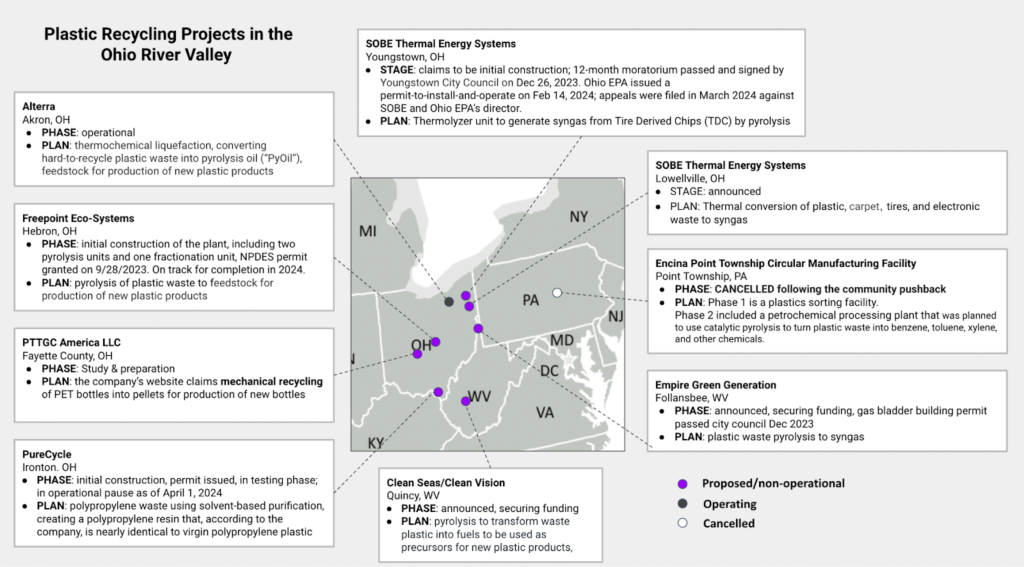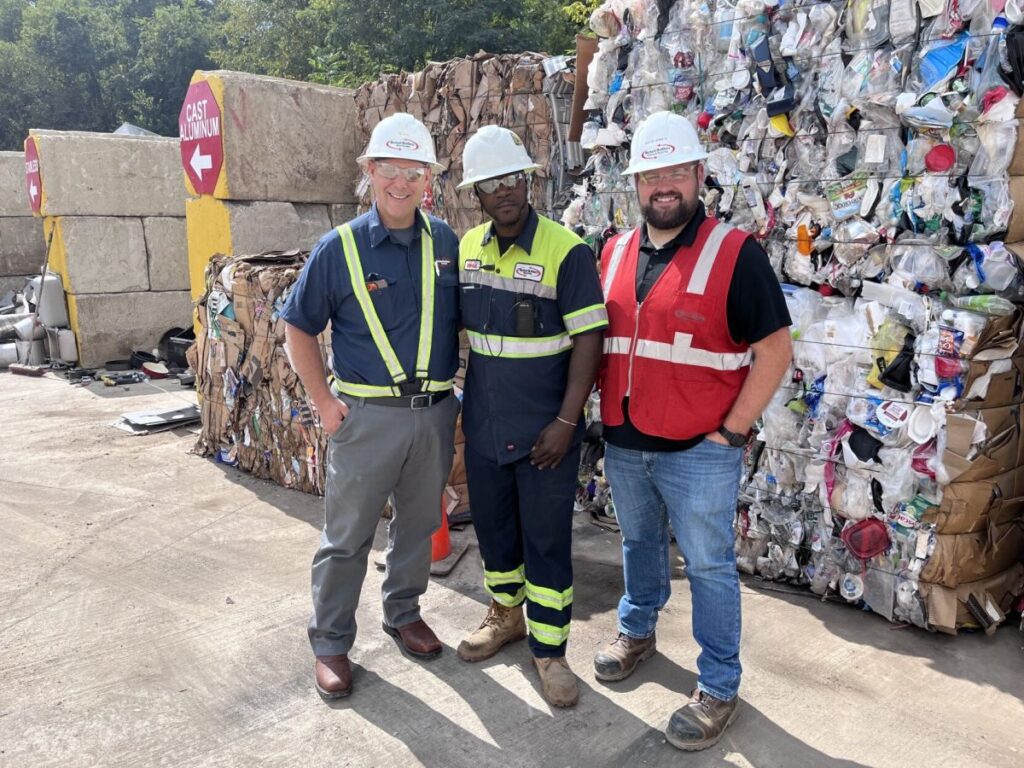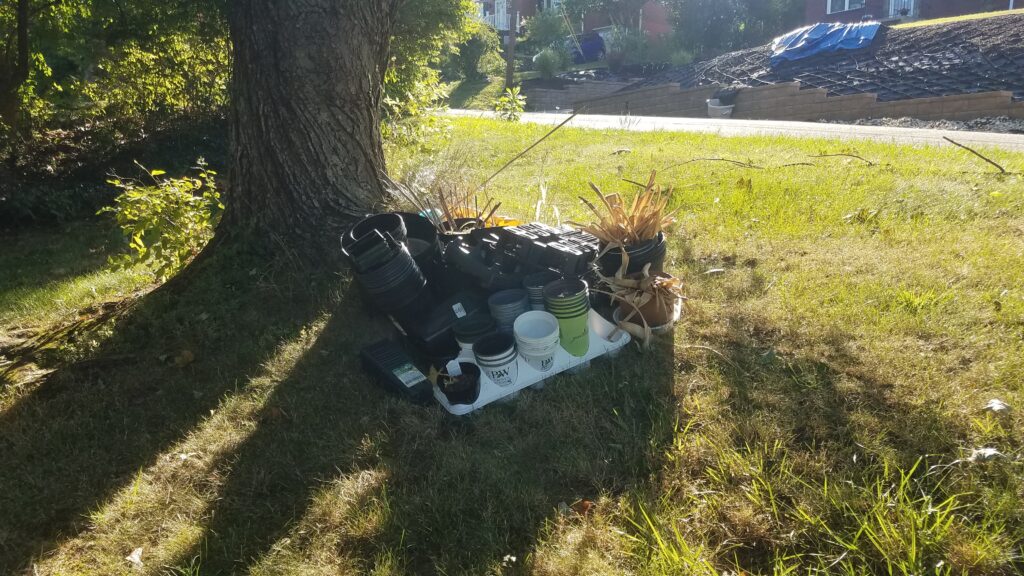Part 4
Over the course of the past few years, plastics recycling categories at Michael Brothers Hauling and Recycling (where I take my recyclables) have shifted. [1] When they first started taking plastics, they asked people to sort out #1 and #2-7; then #1, #2, and #3-7; and now they’re accepting everything in one stream. Even at the beginning, when they asked people to sort all #1 plastics together in the same bin, I was confused because there are actually different types of #1 plastic, and they’re not all recyclable. I wasn’t sure what was actually happening to the stream, but the person I talked to at Michael Brothers at the time said the buyer didn’t care about all different types of #1 plastic being mixed together. That piqued my curiosity… and my concern.

Image credit: [2]
I had been sorting my plastic into three categories (#1, #2, and #3-7) until recently, when Michael Brothers put out a single “all plastics” dumpster in their recycling area. Since I knew they used to send the #2-#7 plastic they collected to a company making “recycled” products, [3] the thought crossed my mind that all of this commingled plastic in the new dumpster could be headed to a chemical recycling facility, especially since we already have some built or planned within a few hours of Pittsburgh. If my plastic waste (no matter how small compared to the per capita average in the US) could be contributing to this growing industry of chemical recycling, I wanted to know – and find an alternative.
Doing the “Right Thing“ is hard when you don’t know what it is
To be clear: there’s no “good” answer to the question of what we should do with our plastics after we’re done with them. Unfortunately, there is a common perception (supported by the plastics industry for decades) that recycling would work if only more people would recycle, or – more recently – if more plastics were recyclable. Curbside recycling programs (no matter how well-intentioned) have allowed us to stop thinking critically about our waste as we throw more into the recycle bin and hope the recyclable materials make it where they need to go. Now the advent of chemical recycling enables proponents of the technology to claim that previously un-recyclable plastics can now be recycled. And even though I know better, over the past few years since Michael Brothers has started taking plastics, I have felt myself slip into that mentality of “at least there’s a place for my plastic waste to go that’s not a landfill, at least that’s a little bit better.” Except it’s not – and I know that now too.
Research has demonstrated that chemical recycling facilities are actually producing very little plastic: 1-14% [4] or 15-20% [5] of the plastic waste that goes in goes back to being plastic, depending on whom you ask. Now, you may feel (as I once did) that 20%, even 1% is better than nothing, especially since it has been demonstrated that using recycled plastic results in 30-40% fewer greenhouse gas emissions than virgin plastic. (Note: it appears that 30-40% statistic is based on mechanical recycling, not chemical recycling.) [6] The concern remains that the vast majority of outputs from chemical recycling facilities are emissions, fuel, or hazardous waste, none of which is beneficial for the environment or the people living nearby. [7]

Image credit: [8]
While there are multiple processes that could be used for chemical recycling, none of the facilities in the US is currently producing plastic at scale, indicating that even if a chemical recycling method is technically feasible, it may not be economically viable. [9] The Brightmark facility covered in Part 2 of this series uses pyrolysis to break down plastic waste, a process that has been described as “ten to 100 times higher—or worse—compared to using virgin polymers to make plastic” when it comes to economic and environmental factors. [10] I heard this statistic last summer and found it concerning, but I saw it in a meme, which gave me pause before changing my behavior altogether or advising friends who asked me what I knew about it. I knew that additional research was needed, so here I am, almost a year later, finally getting around to it.
“The truth will set you free, but first it will piss you off.”
So that takes me back to Michael Brothers. My buddy there, referred to by his coworkers as “the plastics guy,” explained to me that they now no longer send the plastic they collect directly to an end user. Instead, all of their plastics, commingled, go on to a local MRF, where they are separated into the different categories of plastic and sent on from there, but he didn’t have any visibility into where they went from either of the two local MRFs. That plural surprised me: I knew there was a MRF on Neville Island, but he told me that there is also one in Hazelwood, which turns out to be less than two miles from my office. [11] My next step was to contact the MRFs directly, but I had no idea what to expect regarding how much they’d be able to tell me.
I was saddened that the one by my office didn’t respond after multiple calls, but I was pleasantly surprised that the team from Waste Management (which runs the MRF on Neville Island) made sure I got as much information as they could provide. Waste Management told me that their MRF accepts material from third-party haulers across western Pennsylvania and part of West Virginia. Their sorting process separates #1, #2, and #5 plastics (bottles, jars, jugs, and tubs only!), which then go to plastics processors throughout the Southeast US that produce carpet, bottles, and clothing. Anything else (including #1, #2, and #5 items that are not a bottle, jar, jug, or tub) are landfilled because there is not currently a market for them.

I was, on one hand, relieved to learn that the bags and bags of plastic films, and wraps, and bags I’ve collected over the years and taken to Michael Brothers were not sitting in a storehouse somewhere waiting for pyrolysis to turn them back into oil. On the other hand, it saddened me to think of just how much plastic I had ultimately sent to the landfill (by way of our local MRFs). In reality, some of it is probably in a French drain somewhere, [12] which is also better than the chemical recycling alternative. Given the climate, public health, and economic risks of chemical recycling, we have seen that it is “better to contain [plastic] in a landfill than burn it,” according to Beyond Plastics’ Alexis Goldsmith. [13]
But that still brings us back to the place we’ve landed at the end of every Plastic Free July: just use less to start with. If we’re talking about mechanical recycling, that’s better than landfilling, but only if you’re sending clean #1, #2, and #5 bottles, jars, jugs, or tubs to your recycler or your curbside bin. If we’re talking about chemical recycling, landfilling is the better option, but the best option – above all – is not using plastic in the first place. I know how hard an ask that is because I’ve been struggling with it myself for years – especially this year. If nothing else, I hope that seeing the large amount of unrecyclable plastic that I will now be putting directly in my garbage will help remind me of how much waste I’m actually creating… and help encourage me to continue to consume less plastic wherever possible.
~
How did you make out this month if you took a Plastic Free July pledge? I’d love to hear about anything you learned or changed.
Thanks for reading!
[1] https://michaelbrothershauling.com/
[2] https://ohiorivervalleyinstitute.org/chemical-recycling-a-false-promise-for-the-ohio-river-valley/
[3] https://radicalmoderate.online/plastic-waste-options-in-pittsburgh/
[4] https://insideclimatenews.org/news/19012023/plastic-advanced-recycling-cost-environmental-impact
[5] https://www.ehn.org/chemical-recycling-ohio-river-valley-2668774021.html
[6] https://e360.yale.edu/features/advanced-plastics-recycling-pyrolysis
[7] https://www.ehn.org/chemical-recycling-ohio-river-valley-2668774021.html
[8] https://www.thealmanac.net/news/2023/oct/15/michael-brothers-shows-its-mettle-in-recycling/
[9] https://ohiorivervalleyinstitute.org/chemical-recycling-a-false-promise-for-the-ohio-river-valley/
[10] https://insideclimatenews.org/news/19012023/plastic-advanced-recycling-cost-environmental-impact/
[13] https://e360.yale.edu/features/advanced-plastics-recycling-pyrolysis
1 Comment
rjwarren59c8cb9109c0 · July 28, 2024 at 10:56 am
Plastics are a Human convenience.
A producer and manufacturers dream product. Some Fokes faces look plastic🤔😔. We lived in a world of Too Much.